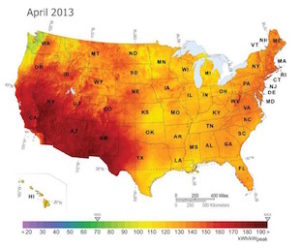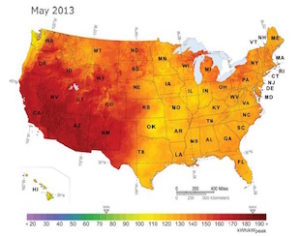By Adam Kankiewicz October 21, 2013

The PV Power Map is a report of national solar resource availability as illustrated by the monthly energy output of a nominal 1-kilowatt (kW) photovoltaic (PV) system by location. During April and May, several regions had noticeable monthly swings in PV energy production.

Above-average PV energy production prevailed across the Southwest during both April and May, as drought conditions continued in the region. PV energy production was above average for the Northeast during April, but slipped to average production conditions in May due to increased storminess. PV energy production in the upper central United States dipped in April due to wetter than average conditions, but bounced back to near-normal production in May. The effects of both the coastal stratus and inland valley clouds can be seen easing over the coastal and central valley regions of California from April to May.

The PV Power Map can be used by anyone to quickly gauge the generation potential of a new PV system, or benchmark the performance of an installed system, in a given location. Simply multiply the power output indicated on the map by a project’s capacity, in kilowatts, to calculate the total estimated power output for the month.
For example, a 4-kW PV system in Jersey City, N.J., would have produced approximately 560 kilowatt- hours during April (140 kWh x 4 kW = 560 kWh). Meanwhile, a 4-kW system in Boulder, Colo., would have produced approximately 600 kWh during May (150 kWh x 4 kW = 600 kWh).
The PV Power Map is created with power output estimates generated by SolarAnywhere services from Clean Power Research; these include simulation capabilities and hourly satellite-derived irradiance data with spatial resolutions from 1 to 10 kilometers. The calculations are based on a PV system with a total 1-kW nameplate rating that is configured as five 200-watt PV panels with a 1.5-kW inverter; fixed, south-facing panels with 30 degree tilt; no shading; panel PVUSA Test Conditions rating of 178 watts; and inverter efficiency of 95.5 percent. Visualization and mapping provided by GeoModel Solar. Access free historical irradiance data at solaranywhere.com.
Adam Kankiewicz (askcpr@cleanpower.com) is a research specialist at Clean Power Research.
Also see Clean Power Research and SolarGIS.




